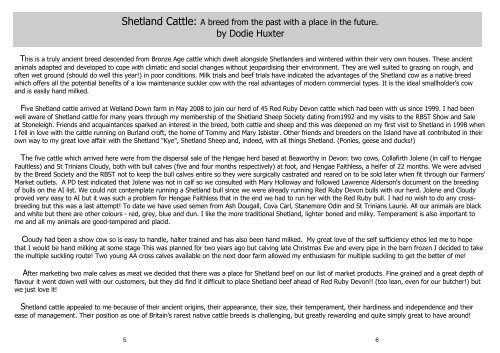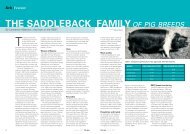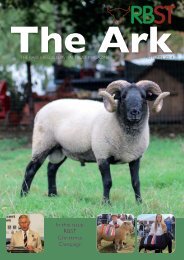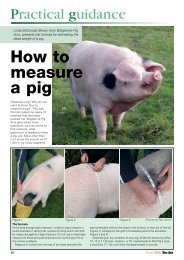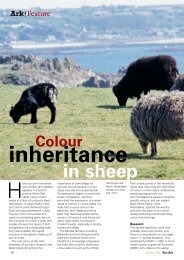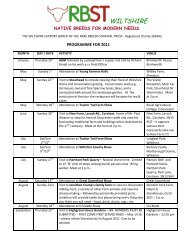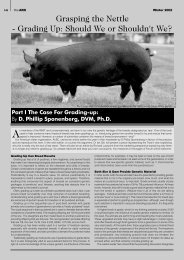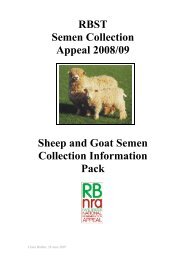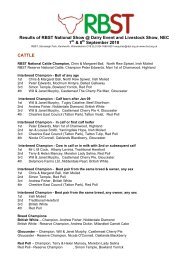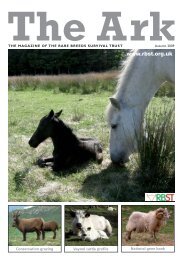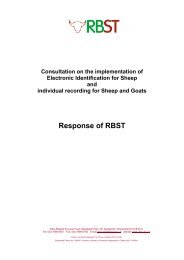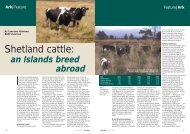Summer 2012 News Letter - RBST Devon
Summer 2012 News Letter - RBST Devon
Summer 2012 News Letter - RBST Devon
Create successful ePaper yourself
Turn your PDF publications into a flip-book with our unique Google optimized e-Paper software.
Shetland Cattle: A breed from the past with a place in the future.<br />
by Dodie Huxter<br />
This is a truly ancient breed descended from Bronze Age cattle which dwelt alongside Shetlanders and wintered within their very own houses. These ancient<br />
animals adapted and developed to cope with climatic and social changes without jeopardising their environment. They are well suited to grazing on rough, and<br />
often wet ground (should do well this year!) in poor conditions. Milk trials and beef trials have indicated the advantages of the Shetland cow as a native breed<br />
which offers all the potential benefits of a low maintenance suckler cow with the real advantages of modern commercial types. It is the ideal smallholder's cow<br />
and is easily hand milked.<br />
Five Shetland cattle arrived at Welland Down farm in May 2008 to join our herd of 45 Red Ruby <strong>Devon</strong> cattle which had been with us since 1999. I had been<br />
well aware of Shetland cattle for many years through my membership of the Shetland Sheep Society dating from1992 and my visits to the <strong>RBST</strong> Show and Sale<br />
at Stoneleigh. Friends and acquaintances sparked an interest in the breed, both cattle and sheep and this was deepened on my first visit to Shetland in 1998 when<br />
I fell in love with the cattle running on Burland croft, the home of Tommy and Mary Isbister. Other friends and breeders on the Island have all contributed in their<br />
own way to my great love affair with the Shetland "Kye", Shetland Sheep and, indeed, with all things Shetland. (Ponies, geese and ducks!)<br />
The five cattle which arrived here were from the dispersal sale of the Hengae herd based at Beaworthy in <strong>Devon</strong>: two cows, Collafirth Jolene (in calf to Hengae<br />
Faultless) and St Trinians Cloudy, both with bull calves (five and four months respectively) at foot, and Hengae Faithless, a heifer of 22 months. We were advised<br />
by the Breed Society and the <strong>RBST</strong> not to keep the bull calves entire so they were surgically castrated and reared on to be sold later when fit through our Farmers'<br />
Market outlets. A PD test indicated that Jolene was not in calf so we consulted with Mary Holloway and followed Lawrence Alderson's document on the breeding<br />
of bulls on the AI list. We could not contemplate running a Shetland bull since we were already running Red Ruby <strong>Devon</strong> bulls with our herd. Jolene and Cloudy<br />
proved very easy to AI but it was such a problem for Hengae Faithless that in the end we had to run her with the Red Ruby bull. I had no wish to do any crossbreeding<br />
but this was a last attempt! To date we have used semen from Ash Dougall, Cova Carl, Stanemore Odin and St Trinians Laurie. All our animals are black<br />
and white but there are other colours - red, grey, blue and dun. I like the more traditional Shetland, lighter boned and milky. Temperament is also important to<br />
me and all my animals are good-tempered and placid.<br />
Cloudy had been a show cow so is easy to handle, halter trained and has also been hand milked. My great love of the self sufficiency ethos led me to hope<br />
that I would be hand milking at some stage This was planned for two years ago but calving late Christmas Eve and every pipe in the barn frozen I decided to take<br />
the multiple suckling route! Two young AA cross calves available on the next door farm allowed my enthusiasm for multiple suckling to get the better of me!<br />
After marketing two male calves as meat we decided that there was a place for Shetland beef on our list of market products. Fine grained and a great depth of<br />
flavour it went down well with our customers, but they did find it difficult to place Shetland beef ahead of Red Ruby <strong>Devon</strong>!! (too lean, even for our butcher!) but<br />
we just love it!<br />
Shetland cattle appealed to me because of their ancient origins, their appearance, their size, their temperament, their hardiness and independence and their<br />
ease of management. Their position as one of Britain's rarest native cattle breeds is challenging, but greatly rewarding and quite simply great to have around!<br />
5 6


